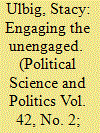| Srl | Item |
| 1 |
ID:
183015


|
|
|
|
|
| Summary/Abstract |
The rebound of ISIS in the online environment in the aftermath of the coalition force liberation of Mosul and Raqqa has reinvigorated the need to understand the strategic choices of the group’s media campaign. This study explores ISIS’s use of dynamic vs. static imagery, with a particular focus on how the image form helps facilitate the group’s goals. Experimental studies document that the use of dynamic imagery heightens viewer attention, recall, and reaction to visual content, while fMRI studies add that audiences process dynamic still images as imagined movements. Using a content analysis of 3745 images in Dabiq, Rumiyah, and al-Naba’ from July 2014 to September 2018, we found that ISIS relies heavily on dynamic imagery in its print media campaign. The deployment of the visual strategy, however, displays significant variation based on the language of the target audience, the primary message content displayed in the photographs, and level of military force opposition the group is facing when it disseminates magazines and newsletters.
|
|
|
|
|
|
|
|
|
|
|
|
|
|
|
|
| 2 |
ID:
092563


|
|
|
|
|
| Publication |
2009.
|
| Summary/Abstract |
As the nation witnesses a distinct decline in civic engagement among young adults, political science instructors across the nation face the formidable task of engaging students in lower-level, general education courses outside students' primary domain of interest. The research presented here seeks to understand if visually enhanced lecture material can effectively engage such students better than more traditional methods of classroom delivery. The project utilizes an experimental design involving two different sections of the same introductory American government course. By exposing the sections to different visual presentations, and controlling for a variety of potentially confounding factors, the impact that simple visual images have on student engagement both inside and outside the classroom are isolated. Findings suggest that the use of simple visual images can enhance students' impressions of the discipline of political science and boost their interest in and knowledge of politics and public affairs more generally.
|
|
|
|
|
|
|
|
|
|
|
|
|
|
|
|